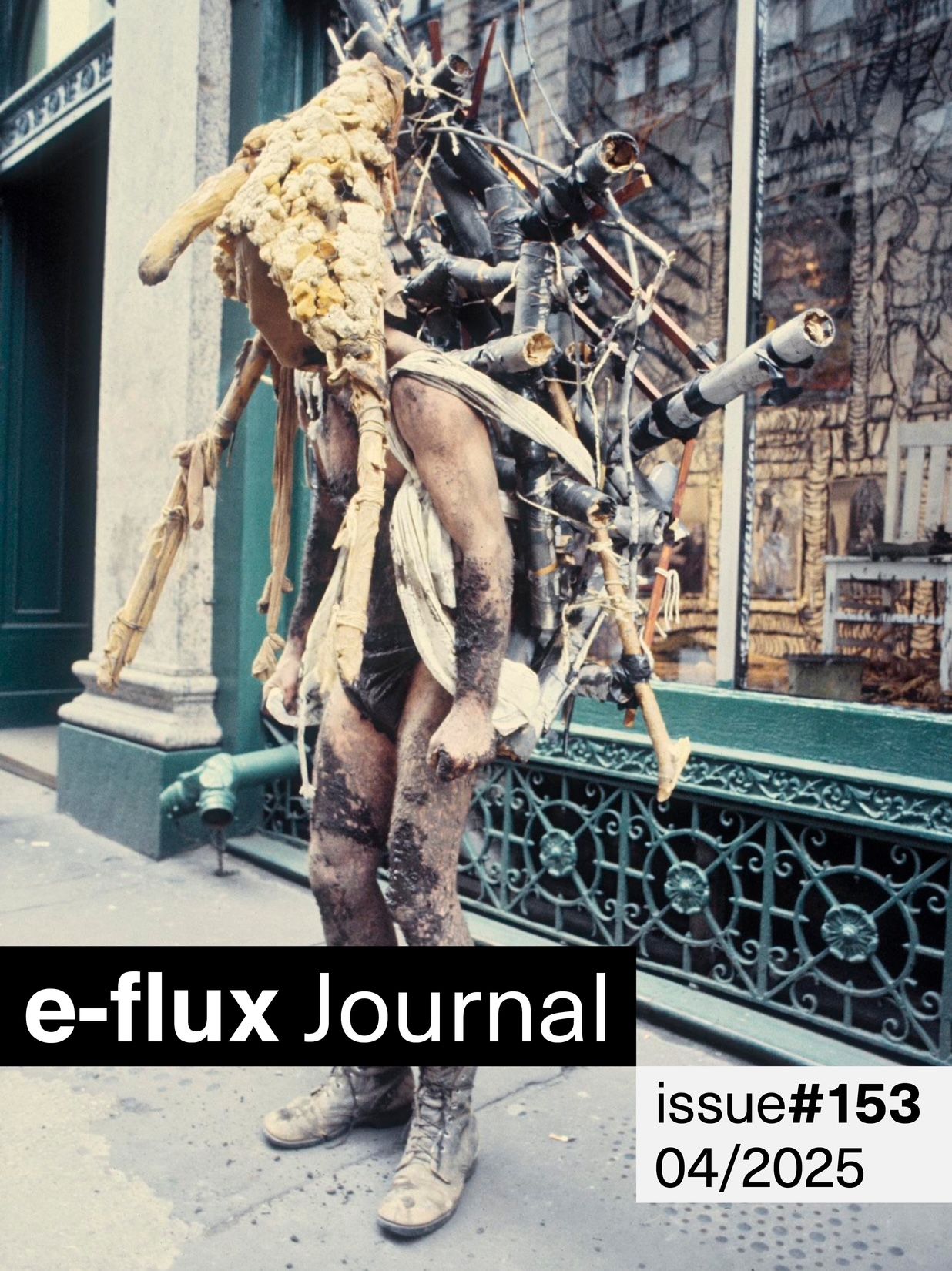e-flux journal issue 118
with Shuddhabrata Sengupta, Jonas Staal, ruangrupa and Nikos Papastergiadis, Marcello Tarì and Matt Peterson, Pelin Tan, Patrick Rosal, Alaina Claire Feldman, and Luis Camnitzer
“But these, dear Indians, dear Hindus, are your leaders and your holy men. They are your mirrors and your death wish. Take a good look at them. Because they are not looking out for you.” These scathing words by Shuddhabrata Sengupta, from a piece published recently in India and reprinted in this issue of e-flux journal, condemn the country’s leaders for their role in fostering the conditions that led to the catastrophic number of coronavirus deaths the country is now suffering. It is not just India’s political leaders that are at fault, but also the holy men who advise them—spiritual leaders whose fatalism and deference before higher powers became lethal in the human, political domain of real needs. This is not to say that the holy men are frauds. On the contrary, the immediate horror of the pandemic in India is actually a reflection of their deference to cosmic forces that are completely indifferent to human life. The holy men are even as holy as the stars—stars that we should all remember don’t give two fucks about us, about administration or politics concerning people and life: “The stars, indifferent in heaven, feel no need to laugh at you. Frankly, no matter what you think about them, they don’t even care about you.”
Also in this issue, Jonas Staal urges the consideration of different forms and recognitions of collectivization necessary for whichever egalitarian futures could be in store for us—if we could only get past the propaganda that has us cower in mortal terror alone, and most certainly not together. As they prepare for their documenta in 2022, ruangrupa share a particularly fecund form of collective practice that informs all of the group’s artistic activities. The “lumbung,” a building that Indonesian farmers use to store surplus crops after harvest, becomes a source of ongoing nourishment for the entire community. In a conversation in this issue, ruangrupa detail how this concept—the opposite of hoarding and exclusion in every way—might play out in the art world and its extended environs.
The Italian researcher Marcello Tarì disagrees with at least some of the ideas expressed above. “The gateway to the transformation of self and world,” he writes in this issue, “… is not to be found in ‘collectivization’ or in the affirmation of will.” Such means, along with state reform and technological acceleration, Tarì holds, don’t allow the truth and the reality of existence to meet. He describes revolution and love as deeply parallel experiences, and also has a short conversation with Matt Peterson of Woodbine on the themes of spirituality and combat.
Pelin Tan takes a trip, via filmmakers Joana Hadjithomas and Khalil Joreige, to İzmir, which is or was also Smyrna. The visits both imaginary and real are made together in spirit and in conversation with Etel Adnan, and Hadjithomas and Adnan’s twinned family histories, memories of exile, fire, incessant description, nostalgia, and sea. Alaina Claire Feldman guides a deep listening of humpback whale song and traces the cosmic and earthly impacts of its recorded form. In poetry editor Simone White’s second selection for the journal, poet Patrick Rosal pairs exquisite images and blistering words. Finally, Luis Camnitzer pays tender tribute to his friend, Antonio Caro, in a remembrance penned days after the late artist departed.
—Editors
Shuddhabrata Sengupta—Astrology, Mortality, and Indifference to Life
Good Hindus, emboldened by Karma and the theory of reincarnation, get more than one chance at the game of life. Death may be inevitable, but for the Holinesses, such as the eminence of the Juna Akhada, it is not irreversible. You may die today, but the Karmic debt you incur by voting for Narendra Modi will certainly bring you back tomorrow. So why not, if you want it stronger, dip a little longer in the Kumbh cauldron? You live, you die, you live, you pass on an infection, you kill some more, you die, you live, you die, and so on.
Jonas Staal—Collectivizations
Decades of capitalist propaganda has reduced the notion of collectivization to Stalinist terror. This flattening of the term dismisses the breadth of forms that collectivization can take: from nationalizing communal resources and production, to other-than-human redistribution efforts to establish comradely ecologies. It is therefore essential to explore the collectivized imaginaries and practices—collectivizations, in the plural—that make egalitarian forms of life imaginable and actionable.
ruangrupa and Nikos Papastergiadis in Conversation—Living Lumbung: The Shared Spaces of Art and Life
We are drawing on ideas that bring people together in conversation rather than force them into authoritative processes. Conversations meander, and decisions spring forth. We reduce individual control and ownership. We share power and authority, as well as respecting silence and absence. Ideas emerge organically without clear intellectual ownership. It is a collage: thousands of pieces of ideas come together. Bad ideas are polished up with some collective imagination.
Marcello Tarì and Matt Peterson—“There is No Unhappy Love”: The Communism of Destitution
It seems as if the desire to cancel out the experience of communism over the last decades may have proceeded, step by step, with the desire to cancel out the experience of love. Just as communism has been replaced by an infinite, inconclusive negotiation over rights, so too love has become a contractual affair, an engagement to barter about as if it were any other aspect of existence. Love no longer even has any experience of the end: one is fired, perhaps with an SMS, and if it’s worth the trouble you can put it on your CV.
Pelin Tan—Surpassing Disaster: Haunted by an Imaginary Smyrna
Joana Hadjithomas films from her plane landing in İzmir to show a clear aerial image of its urban spaces and its seashore, a reflection of the imaginary cartography of the place shown to her as a child. The camera often returns to the sea and waves that connect Etel’s living room to Joana’s first visit to the city. The gaze panning the horizon and the seashore reflects the catastrophe that prompted their estrangement from the place. Ismyrna often depicts the landscape of İzmir as well as several old and current maps. As film subjects, the mountains, the sea, the seashore, and even the urbanization of İzmir seem like such innocent bystanders.
Patrick Rosal—Excerpt from Atang: An Altar for Listening to the Beginning of the World
I’d gotten good enough at listening to the dead that I could call them in. Not like they’d come every time I called, but time to time they’d come. And that’s how I’d heard stories from men and women who lived in other times and places. Ancestors. Not long ago. Some of them in California, during the twenties and thirties.
Alaina Claire Feldman—Minor Listening, Major Influence: Revisiting Songs of the Humpback Whale
What is it about these specific sounds and the discourse around them that was able to capture the imagination of so many people and produce such emotional responses and judicial consequences for the environment? While whale vocalizations seem like an obvious and prevalent sonic rendering of nature, the narrative around the Songs of the Humpback Whale record is much more complex than a quick summary can describe. The album had wide-ranging effects far beyond marine biology or burgeoning environmental movements—for instance, making conceptual connections between explorations of the ocean and the cosmos, and creating a now-common way of accessing animal life through certain listening practices.
Luis Camnitzer—Antonio Caro, 1950–2021
Antonio died on March 29, 2021, apparently from heart failure, the primary organ he used to generate his works. He died prematurely at the age of seventy. He has been one of the few irreplaceable characters in the art of the South American continent, and luckily, his work will remain and compensate for his leaving us.










